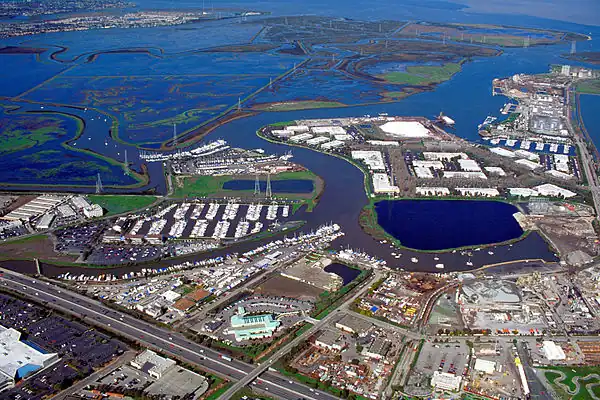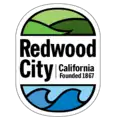| Redwood Creek | |
|---|---|
 Aerial view of the mouth of Redwood Creek on San Francisco Bay at the port of Redwood City, California | |
 Location of the Redwood Creek estuary in San Francisco Bay | |
| Etymology | Spanish language |
| Location | |
| Country | United States |
| State | California |
| Region | San Mateo County |
| City | Redwood City, California |
| Physical characteristics | |
| Source | Arroyo Ojo De Agua |
| • location | Redwood City |
| • coordinates | 37°27′27.8″N 122°15′58.9″W / 37.457722°N 122.266361°W |
| 2nd source | Arroyo Salinas |
| • location | Woodside, California |
| • coordinates | 37°26′35.4″N 122°15′39.4″W / 37.443167°N 122.260944°W |
| Source confluence | Redwoods Embarcadero Creek |
| • coordinates | 37°29′12.8″N 122°13′38.3″W / 37.486889°N 122.227306°W |
| Mouth | Redwood Slough |
• coordinates | 37°31′35.1″N 122°11′46.4″W / 37.526417°N 122.196222°W[1] |
| Discharge | |
| • average | 1,370[2] cu ft/s (39 m3/s) |
| • minimum | 17 cu ft/s (0.48 m3/s) |
| • maximum | 14,000 cu ft/s (400 m3/s) |
| Basin features | |
| Tributaries | |
| • left | Arroyo Ojo De Agua |
| • right | Arroyo Salinas |
Redwood Creek is a 9.5-mile-long (15.3 km)[3] perennial stream located in San Mateo County, California, United States which discharges into South San Francisco Bay.[1] The Port of Redwood City, the largest deepwater port in South San Francisco Bay, is situated on the east bank of Redwood Creek near its mouth, where the creek becomes a natural deepwater channel.
History
The creek and city name, the latter first known as Red Woods City (1854), was named because of the nearby coast redwood (Sequoia sempervirens) forest and lumbering industry.[4] In 1851, a deep-water channel that ran inland to what is now Redwood City was discovered off of San Francisco Bay. Named Redwood Creek, this channel was used by the lumber companies to ship wood and logs from the redwood forests in the peninsula hills to San Francisco. A shipbuilding industry emerged, the first schooner was built in 1851 by G.M. Burnham and appropriately named "Redwood." Wooden shipbuilding remained an active industry until the last wooden ship built in Redwood City, called the "Perseverance," was launched in 1883.[5] The shipbuilding industry experienced a revival in 1918 with the building of the first concrete ship in America, the SS Faith.[6]
The Port of Redwood City would be used in rebuilding efforts after the 1906 Earthquake in San Francisco. The port would continue to be a crucial area for emergency response, with FEMA designating it as a federal staging area for natural disasters in 2017. The port would also be used during WWII, as the US Navy took over the port in 1944 for it freight needs. In the 1950s, the port would used to transport 27 million tons of cargo.[7]
Watershed
Redwood Creek begins in the Woodside Glens neighborhood of Woodside, California just south of Interstate 280, below the terminus of Farm Hill Boulevard. It descends below Interstate 280 on the west side of Woodside Road, passing through the Menlo Country Club. At Alameda de las Pulgas it becomes an engineered concrete channel to El Camino Real, where it is briefly daylighted before entering underground culverts in downtown Redwood City. The primary tributary to Redwood Creek is a stream named Arroyo Ojo de Agua which meets it underground at approximately Broadway Street in Redwood City.[8][9] As it crosses below US Highway 101 it becomes a tidal channel. Extensive mudflats and marsh areas are found along Redwood Creek near its mouth. Several side channel sloughs connect to Redwood Creek, the largest of which is Westpoint Slough.
The U.S. Geological Survey (USGS) and National Park Service (NPS) have conducted studies to observe and quantify erosion and sedimentation processes in the watershed. These studies have allowed researchers to determine the long-term effects of certain land practices and how they change the hillslopes and stream channels. These studies determined that the cumulative effect of these land practices was able to initiate multiple erosion processes, which generated a significant impact on the Redwood Creek Basin.[10]
Ecology
Redwood Creek and Arroyo Ojo de Agua were fish sampled for steelhead trout (Oncorhynchus mykiss) in 1981, but no trout were found. The historical status of trout in the creek is unknown.[11]
At Stulsaft Park on the Arroyo de Ojo Agua tributary, a population of endangered Fountain Thistle (Cirsium fontinale var. fontinale) was discovered in 2007, and occupies seeps associated with serpentine soils. In Stulsaft Park it is found in an opening in a coffeeberry/bay laurel woodland. The plants may grow 6 feet tall and it is only found in a handful of locations in San Mateo County.
A study conducted in 2016 that analyzed sediments in the Redwood Creek region determined that the benthic organisms in Redwood Creek were not significantly affected by the polychlorinated biphenyls (PCBs) in the sediment. However, the study determined that these PCBs could pass through the food chain and impact humans that consume fish from Redwood Creek. The study determined that these chemicals can have carcinogenic risks to the humans that consume them through fish from Redwood Creek.[12]
In August, 2018 Grassroots Ecology Assistant Director Junko Bryant led a project with the San Jose Conservation Corps and Redwood City to remove approximately 40 non-native Canary Island date palm (Phoenix canariensis) trees from a segment of Redwood Creek in the downtown area near Kaiser Permanente. These palm trees, some over 5 feet in diameter, had overtaken the creek bank and completely obscured public views of the creek. The creek banks have been replanted with native plants, increasing biological diversity and improving visibility for ambulances accessing the hospital.[13]
Gallery
|
See also
References
- 1 2 "Redwood Creek". Geographic Names Information System. United States Geological Survey, United States Department of the Interior. 19 January 1981. Retrieved 30 November 2016.
- ↑ "USGS Gage #11482500 on Redwood Creek, Ca". U.S. Geological Survey. Retrieved 1 December 2016.
- ↑ U.S. Geological Survey. National Hydrography Dataset high-resolution flowline data. The National Map, accessed 2012-02-11
- ↑ Bright, William (30 November 1998). 1500 California place names their origin and meaning. University of California Press. p. 123. ISBN 978-0-520-21271-8. Retrieved 2012-02-11.
- ↑ "The History of Redwood City". RWC Local History. 2011. Retrieved 14 November 2016.
- ↑ "THREE CONCRETE SHIPS WILL BE CONSTRUCTED AT REDWOOD". The Stanford Daily. No. 9. 12 April 1918. p. 4. Retrieved 3 January 2017.
- ↑ "History". Port of Redwood. Retrieved 2021-11-09.
- ↑ "Arroyo Ojo de Agua". Geographic Names Information System. United States Geological Survey, United States Department of the Interior.
- ↑ "Redwood Creek Watershed Map". Oakland Museum. Retrieved 2012-02-12.
- ↑ "Surface erosion by overland flow in the redwood creek basin, northwestern California — effects on logging and rock type". International Journal of Rock Mechanics and Mining Sciences & Geomechanics Abstracts. 33 (7): A292. October 1996. doi:10.1016/0148-9062(96)83337-7. ISSN 0148-9062.
- ↑ Leidy, Robert A.; Becker, Gordon S.; Harvey, Brett N. (2005). "Historical Distribution and Current Status of Steelhead/Rainbow Trout (Oncorhynchus mykiss) in Streams of the San Francisco Estuary, California" (PDF). Oakland, CA: Center for Ecosystem Management and Restoration. pp. 146–147. Retrieved 7 December 2016.
- ↑ "Redwood Creek Characterization Report". Redwood City. 9 November 2016.
- ↑ "Making Way for Restoration in Redwood City". From the Ground Up. Grassroots Ecology. August 1, 2018. Retrieved February 7, 2020.





.jpg.webp)

